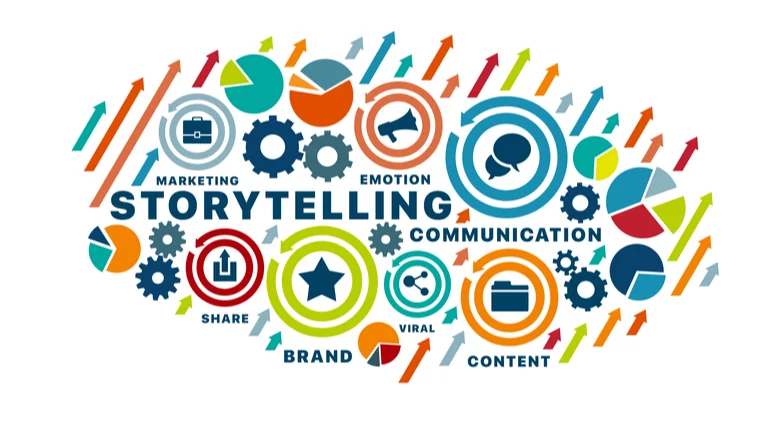Storytelling in branding is not just about weaving fantastical tales; it’s about forging a deep connection with your audience. By tapping into the human psyche, stories have the ability to captivate, inspire, and influence like no other. Imagine this: a world where your brand isn’t just another logo, but a character with a unique story. People love stories, they crave them. And what better way to engage them than by crafting authentic narratives that evoke emotions?
Storytelling allows you to create that coveted emotional connection, making your brand relatable and memorable. But wait, there’s more! To truly make an impact, you must first understand your audience – their desires, fears, and dreams. Only then can you craft stories that resonate with them on a personal level? Authenticity is key here, my friend. Be genuine, be real. No one likes a phoney story. Now, don’t limit yourself to a single channel. Embrace the versatility of storytelling by exploring different platforms – from social media to videos and even good old blogs.
Adapt your stories to suit each medium, ensuring that your message reaches far and wide. So, my fellow marketer, let us wield the power of storytelling together and forge those emotional bonds with our audience. May your tales be captivating, your characters unforgettable, and your brand lives on in the hearts and minds of all who hear your story.
Table of Contents
ToggleThe Basics of Storytelling In Branding
Storytelling is not just a fancy term thrown around in the marketing world. It’s all about telling a tale that captivates your audience and leaves them wanting more. It’s like being a magician, but instead of pulling rabbits out of hats, you’re pulling heartstrings and emotions. So, what makes a good story? It’s all about the elements.
You need a relatable protagonist, a conflict and a resolution that leaves your audience feeling warm and fuzzy inside. Add a dash of humour, sprinkle some unexpected twists, and you have a recipe for success. But hang on a second, aren’t we supposed to be talking about branding? Absolutely! When it comes to branding, storytelling is your secret weapon. Telling a compelling story about your brand creates a deep emotional connection with your audience. It helps them understand your values, your purpose, and why they should choose you over your competitors.
Storytelling allows you to break through the noise and stand out in a sea of sameness. It enables you to connect with your audience on a human level, making your brand more relatable and memorable. So, don’t be afraid to get creative and put your storytelling skills to the test. Your brand will thank you, and your audience will applaud you for it.
Creating Emotional Connections
When it comes to storytelling in branding, connecting with consumers on an emotional level is crucial. And how do you do that? Well, through the power of storytelling, of course! By crafting narratives that resonate with your audience, you can tap into their deepest emotions and forge strong connections with your brand. To create emotional connections, you need to dig deeper and understand what motivates your target audience.
What are their hopes, fears, and dreams? Once you have that insight, you can weave those emotions into your brand stories. Maybe you want to make them feel inspired, nostalgic, or even empowered. Whatever the emotion, your stories should evoke a response from your audience. Authenticity is key when it comes to crafting emotional stories. People can sniff out a fake narrative from a mile away, so be genuine. Don’t try to mimic the latest viral trend or imitate your competitors. Instead, be true to your brand’s values and mission. Tell stories that are uniquely yours, stories that only your brand can tell.
Now, let’s talk about the channels through which you can tell these stories. With today’s technology, you have an array of options at your fingertips. From social media to videos to blog posts, choose the channels that best suit your brand and your audience. Experiment, be creative, and most importantly, be consistent across all platforms. So, are you ready to create some emotional connections? Start tapping into those feelings, crafting authentic stories, and sharing them across different channels. Your audience will thank you for it, and your brand will reap the benefits.
Understanding Your Audience Through Storytelling In Branding
Before you dive headfirst into crafting your epic brand narrative, it’s crucial to understand your audience. You don’t want to be like that aunty at family gatherings who starts telling embarrassing childhood stories when nobody is interested. No, you want to know your audience, what makes them tick, and what resonates with them. Are they millennial hipsters who love avocado toast and vintage vinyl records? Or are they an older, more seasoned crowd who prefer the smooth sounds of Frank Sinatra and classic literature?
Knowing your audience helps you tailor your storytelling in a way that grabs their attention and keeps them hooked. You can’t use the same narrative for everyone – that’s like trying to fit into your teenage skinny jeans. It’s just not going to work. So, before you start spinning your tale, take a deep dive into the demographics, psychographics, and even their social media habits. The more you know, the more powerful your storytelling becomes. And that’s what we’re aiming for here – power, connection, and a sprinkle of magic.
Crafting Authentic Stories
Crafting authentic stories is the key to creating a lasting impact on your audience. In a world where everyone is bombarded with marketing messages, it’s essential to stand out and connect with your customers on a deeper level. One way to craft authentic stories is by tapping into the emotions of your audience. People are more likely to remember a story that evokes a strong emotional response.
So, instead of focusing solely on the features and benefits of your product, think about how it can make people feel. What problem does it solve? How does it improve their lives? Another important aspect of crafting authentic stories is being true to your brand’s values and personality. Don’t try to be something you’re not just to please your audience. Embrace your unique qualities and use them to your advantage. Remember, authenticity is the new cool. People are tired of being sold to. They want honesty and transparency. So, don’t be afraid to show the behind-the-scenes of your business or share personal stories that resonate with your audience.
Lastly, storytelling in branding is not just limited to written content. Explore different channels like videos, podcasts, and social media to tell your stories. Each channel has its own unique storytelling capabilities, so make the most of it. Crafting authentic stories is an ongoing process. It requires creativity, empathy, and a deep understanding of your audience. By investing time and effort into crafting authentic stories, you can create a strong emotional connection with your audience that will set your brand apart from the competition. You can watch some interesting storytelling in branding in this video.
Telling Stories Across Different Channels
Let’s talk about social media. It’s like a playground for brands, with various platforms like Facebook, Instagram, and Twitter just waiting to be conquered. Each platform has its own quirks, so make sure you adapt your story accordingly. Instagram loves captivating visuals, while Twitter demands concise and witty storytelling. But hey, don’t forget about good old email marketing. While it may seem like a dinosaur compared to social media, it’s still a robust channel for storytelling.
Craft personalized and compelling email campaigns that keep your subscribers hooked. Don’t be shy, throw in some humour and make them feel special! Also, let’s not ignore the power of video. YouTube, TikTok, and even good old television commercials are all dreamy platforms for sharing your brand story. Don’t just tell the story, show it! Pull at those heartstrings, make them laugh, make them cry. And if you’re feeling adventurous, go live and interact directly with your audience.
Just remember, consistency is vital. Your storytelling should remain cohesive across all channels, while still adapting to their unique characteristics. It’s like being a chameleon but with words and visuals. No matter what channel you choose, always remember to listen to your audience and engage with them. After all, storytelling is a dialogue, not a monologue.
Conclusion
Ah, the end is near! We’ve reached the conclusion of our storytelling journey. But before we wrap things up, let’s recap the key points we’ve covered so far. Storytelling is a powerful tool in branding. It allows us to create emotional connections with our audience, which can be the driving force behind their loyalty and engagement. Sharing stories that resonate with our target audience helps us form a bond and build trust. To effectively tell stories, it’s crucial to understand our audience.
We need to dig deep and uncover their desires, pain points, and values. This insight will enable us to craft authentic stories that truly resonate and engage. Crafting authentic stories is all about creativity and being real. We should strive for originality and avoid generic or clichéd narratives. Our stories should reflect our brand’s personality, values, and mission. By being unique and staying true to ourselves, we can stand out from the crowd and leave a lasting impression.
Storytelling in branding across different channels is essential. We need to adapt our storytelling techniques to fit various platforms like websites, social media, videos, and even offline mediums. By understanding our audience, crafting authentic stories, and leveraging different channels, we can captivate and engage our audience in a way that drives brand loyalty and leaves a lasting impact. So, go forth and tell your story in a way that sets your brand apart from the rest! And with that, my dear readers, we bid adieu.
May your storytelling in branding journey be filled with creativity, authenticity, and a touch of quirkiness. Happy Storytelling!
What’s Next: Why Trademark Registration Is Important for Businesses











